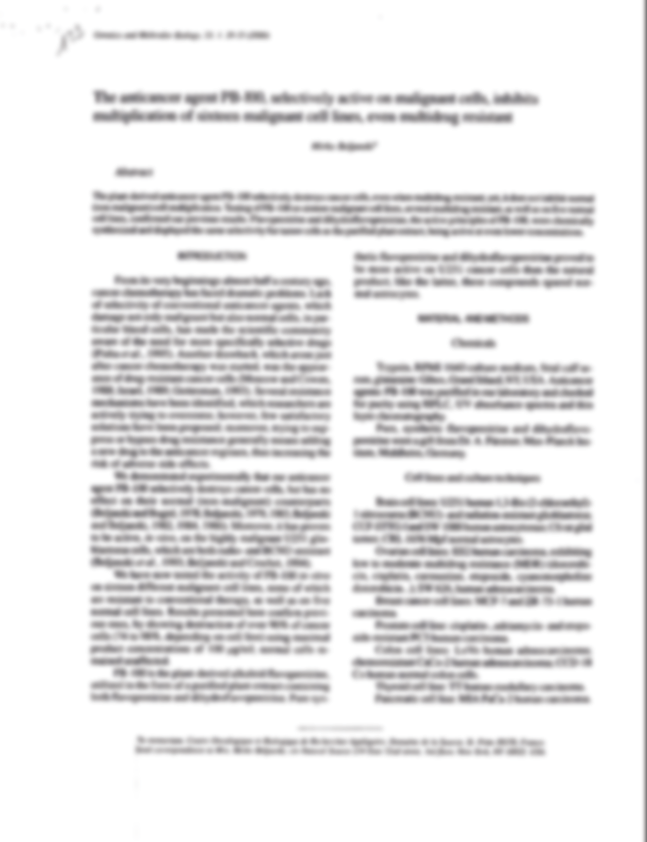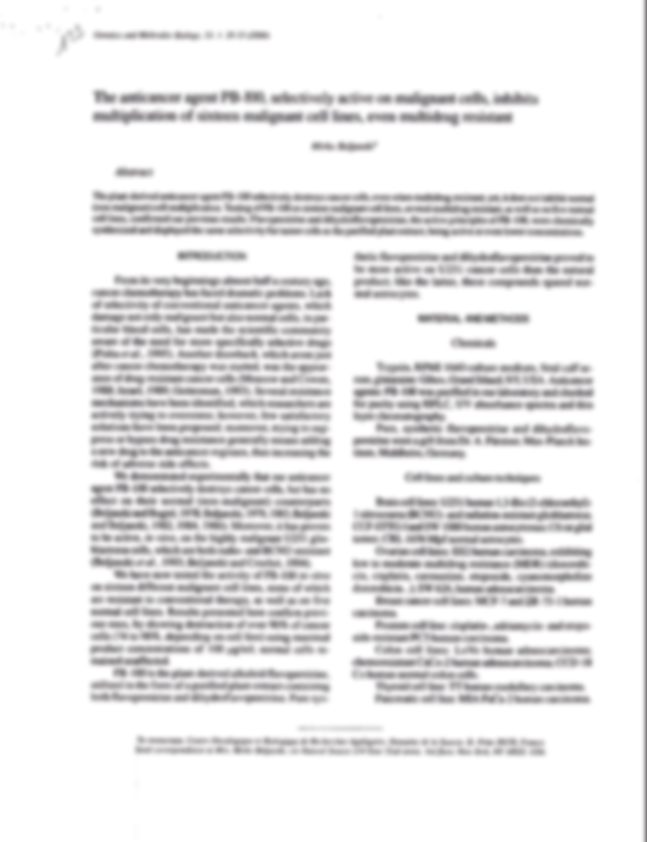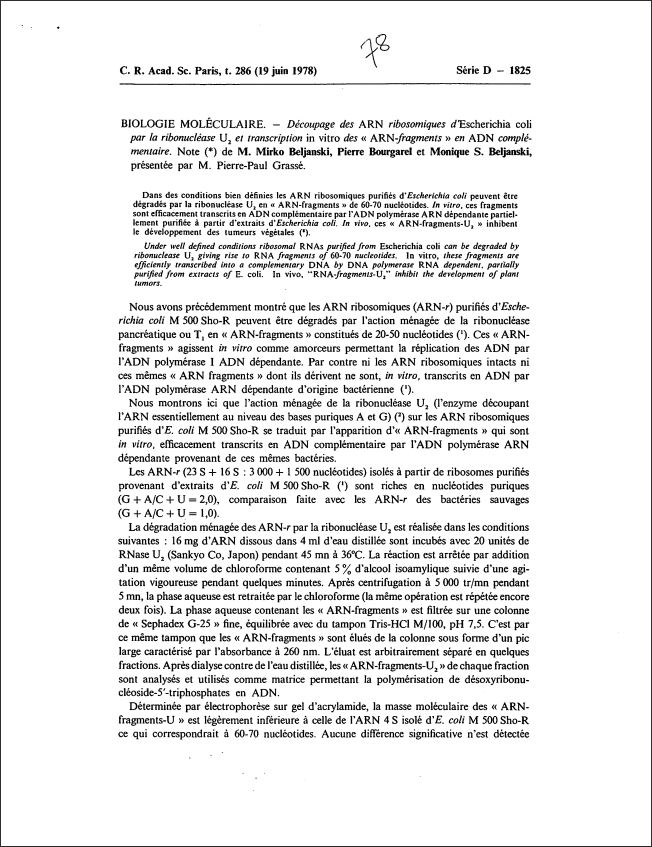83 – Particular RNA Fragments as Promoters of Leukocyte and Platelet Formations in Rabbits
Exp. Cell Biol., 1979, 47, pp. 218-225
Available in English only
ABSTRACT: Under well-defined conditions, ribosomal RNA from Escherichia coli is fragmented by pancreatic ribonuclease, leading to the appearance of particular RNA fragments. Some of these fragments act as primers for in vitro replication of DNA extracted from blood-cell and platelet-forming tissues. In experimental rabbits they restore in a rapid and harmless way normal circulating leukocyte and platelet levels when these have been drastically decreased by various chemotherapeutic agents mainly used in anticancer therapy. Imbalance between polynuclear and lymphocyte count provoked in rabbits by cyclophosphamide can be rapidly corrected by treating the animal with active RNA fragments.
ABSTRACT: Under well-defined conditions, ribosomal RNA from Escherichia coli is fragmented by pancreatic ribonuclease, leading to the appearance of particular RNA fragments. Some of these fragments act as primers for in vitro replication of DNA extracted from blood-cell and platelet-forming tissues. In experimental rabbits they restore in a rapid and harmless way normal circulating leukocyte and platelet levels when these have been drastically decreased by various chemotherapeutic agents mainly used in anticancer therapy. Imbalance between polynuclear and lymphocyte count provoked in rabbits by cyclophosphamide can be rapidly corrected by treating the animal with active RNA fragments.
82 – Stimulation de l’induction – ou inhibition du développement – des tumeurs de Crown-gall par des ARN-fragments U2. Interférence de l’auxine
C.R. Acad. Sci., 1979, 288, pp. 147-150 (série D).
Document not available online
Document not available online
81 – Special short dual-action RNA fragments can both induce and inhibit crown-gall tumors
Proc. 4th Conf. Plant Path. Bacteria, Angers, 1978, pp. 207-220.
Available in English only
ABSTRACT: When ribosomal RNA which contains an excess of purine nucleotides is subjected to mild degradation by a specific ribonuclease, we can isolate specific RNA-fragments which, in vitro, can be described into complementary DNA by an RNA dependent DNA polymerase partially purified from Escherichia coli extracts. These RNA-fragments can either stimulate or inhibit development of crown-gall tumors induced by inoculation of Agrobacterium tumefaciens (oncogenic strain B6) into decapitated germinating pea seedlings (Pisum sativum L cv. Annonay). Stimulation or inhibition of tumor development depends on the time at which the RNA-fragments have been introduced into the bacteria-infected wound. Interaction between RNA-fragments and auxin was also studied. Results obtained both in vitro and in vivo will be described.
ABSTRACT: When ribosomal RNA which contains an excess of purine nucleotides is subjected to mild degradation by a specific ribonuclease, we can isolate specific RNA-fragments which, in vitro, can be described into complementary DNA by an RNA dependent DNA polymerase partially purified from Escherichia coli extracts. These RNA-fragments can either stimulate or inhibit development of crown-gall tumors induced by inoculation of Agrobacterium tumefaciens (oncogenic strain B6) into decapitated germinating pea seedlings (Pisum sativum L cv. Annonay). Stimulation or inhibition of tumor development depends on the time at which the RNA-fragments have been introduced into the bacteria-infected wound. Interaction between RNA-fragments and auxin was also studied. Results obtained both in vitro and in vivo will be described.
80 – Presence of RNA in the Nucleoprotein Complex Spontaneously Released by Human Lymphocytes and Frog Auricles in Culture
Cancer Res., 1978, 38, pp. 3546-3554
Article not available online
Article not available online
ABSTRACT IN FRENCH : Lorsque les taux de leucocytes et de plaquettes dans le sang ont été abaissées par l’effet secondaire de certaines chimiothérapies, ces taux peuvent être ramenés rapidement et sans danger à leurs valeurs normales par les ARN-fragments, les R.L.B.
ABSTRACT IN ENGLISH : When the leucocytes and blood platelets have their counts reduced in the blood following chemotherapy, they can be rapidly and safely, restored to normal values by injecting cellular ARN fragments, which the authors call R.L.B. factors.
78 – Découpage des ARN ribosomiques d’Escherichia coli par la ribonucléase U2 et transcription in vitro des “ARN-fragments” en ADN complémentaire
C.R. Acad. Sci., 1978, 286, pp. 1825-1828 (série D).
Available in French only
ABSTRACT: Under well defined conditions ribosomal RNAs purified from Escherichia coli can be degraded by ribonuclease U2 giving rise to RNA fragments of 60-70 nucleotides. In vitro, these fragments are efficently transcribed into a complementary DNA by DNA polymerase RNA dependent, partially purified from extracts of E. coli. In vivo, “RNA-fragments-U2” inhibit the development of plant tumors.
ABSTRACT: Under well defined conditions ribosomal RNAs purified from Escherichia coli can be degraded by ribonuclease U2 giving rise to RNA fragments of 60-70 nucleotides. In vitro, these fragments are efficently transcribed into a complementary DNA by DNA polymerase RNA dependent, partially purified from extracts of E. coli. In vivo, “RNA-fragments-U2” inhibit the development of plant tumors.
77 – Polyribonucleotides, agents inducteurs et inhibiteurs des tissus tumoraux
Conférence Internationale de Montpellier (1978)
Documents not available online
Documents not available online
76 – Endogenous RNA-Bound RNA Dependent DNA Polymerase Activity in Neurospora crassa
Botany Department, Howard University, Washington, DC
Exp. Mycology, 1977, 1, pp. 173-182.
Available in English only
ABSTRACT: Evidence indicating the presence of a RNA-bound RNA-dependent DNA polymerase (RDDP) in the eukaryotic fungus Neurospora crassa is presented. This enzyme, free of DNA-dependent DNA polymerase, is capable of synthesizing DNA only in the presence of all four deoxyribonucleoside 5′-triphosphates and Mg2+. The DNA polymerase activity is decreased considerably if the RNA bound to the enzyme is eliminated. The activity can be restored by addition of some particular RNA but not by addition of DNA. Both template RNA and the synthesized DNA product sedimented on sucrose density gradients are approximately 6 S. RNA-bound RNA-dependent DNA polymerase partially purified from extracts of N. crassa was distinguishable from known DNA-dependent DNA polymerases. DNA synthesized by RDDP was acid-precipitable and complementary to enzyme-bound RNA.
ABSTRACT: Evidence indicating the presence of a RNA-bound RNA-dependent DNA polymerase (RDDP) in the eukaryotic fungus Neurospora crassa is presented. This enzyme, free of DNA-dependent DNA polymerase, is capable of synthesizing DNA only in the presence of all four deoxyribonucleoside 5′-triphosphates and Mg2+. The DNA polymerase activity is decreased considerably if the RNA bound to the enzyme is eliminated. The activity can be restored by addition of some particular RNA but not by addition of DNA. Both template RNA and the synthesized DNA product sedimented on sucrose density gradients are approximately 6 S. RNA-bound RNA-dependent DNA polymerase partially purified from extracts of N. crassa was distinguishable from known DNA-dependent DNA polymerases. DNA synthesized by RDDP was acid-precipitable and complementary to enzyme-bound RNA.
75 – Particular small size RNA and RNA fragments from different origins as tumor inducing agents in Datura stramonium
Molecular Biology Reports, 1976, 2, pp. 497-506.
Available in English only
ABSTRACT: Particular RNA fragments obtained by action of pancreatic ribonuclease on purified RNAs originating from species totally unrelated to Agrobacterium tumefaciens (Escherichia coli, rabbit, monkey) are capable if inducing the formation of transplantable tumorous tissue when introduced at wounded sites in inverted stems of Datura stramonium maintained under axenic conditions on a medium containing auxin and kinetin. Reovirus RNA and a small size RNA (5-6 S) isolated from RNA bound RNA directed DNA polymerase from Escherichia coli also induced the appearance of tumorous tissues which grow on solid synthetic medium in the absence of auxin and kinetin.
ABSTRACT: Particular RNA fragments obtained by action of pancreatic ribonuclease on purified RNAs originating from species totally unrelated to Agrobacterium tumefaciens (Escherichia coli, rabbit, monkey) are capable if inducing the formation of transplantable tumorous tissue when introduced at wounded sites in inverted stems of Datura stramonium maintained under axenic conditions on a medium containing auxin and kinetin. Reovirus RNA and a small size RNA (5-6 S) isolated from RNA bound RNA directed DNA polymerase from Escherichia coli also induced the appearance of tumorous tissues which grow on solid synthetic medium in the absence of auxin and kinetin.
74 – Un ARN extrait d’Agrobacterium tumefaciens souches oncogènes et non oncogènes, élément indispensable à l’induction des tumeurs chez Datura stramonium
Canadian Journal of microbiology, 1976, 22, pp. 694-700.
Article not available online
Article not available online






